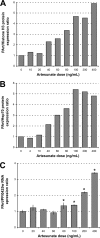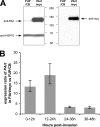Artesunate tolerance in transgenic Plasmodium falciparum parasites overexpressing a tryptophan-rich protein
- PMID: 21464256
- PMCID: PMC3101408
- DOI: 10.1128/AAC.01409-10
Artesunate tolerance in transgenic Plasmodium falciparum parasites overexpressing a tryptophan-rich protein
Abstract
Due to their rapid, potent action on young and mature intraerythrocytic stages, artemisinin derivatives are central to drug combination therapies for Plasmodium falciparum malaria. However, the evidence for emerging parasite resistance/tolerance to artemisinins in southeast Asia is of great concern. A better understanding of artemisinin-related drug activity and resistance mechanisms is urgently needed. A recent transcriptome study of parasites exposed to artesunate led us to identify a series of genes with modified levels of expression in the presence of the drug. The gene presenting the largest mRNA level increase, Pf10_0026 (PArt), encoding a hypothetical protein of unknown function, was chosen for further study. Immunodetection with PArt-specific sera showed that artesunate induced a dose-dependent increase of the protein level. Bioinformatic analysis showed that PArt belongs to a Plasmodium-specific gene family characterized by the presence of a tryptophan-rich domain with a novel hidden Markov model (HMM) profile. Gene disruption could not be achieved, suggesting an essential function. Transgenic parasites overexpressing PArt protein were generated and exhibited tolerance to a spike exposure to high doses of artesunate, with increased survival and reduced growth retardation compared to that of wild-type-treated controls. These data indicate the involvement of PArt in parasite defense mechanisms against artesunate. This is the first report of genetically manipulated parasites displaying a stable and reproducible decreased susceptibility to artesunate, providing new possibilities to investigate the parasite response to artemisinins.
Figures





References
-
- Adams P. A., Berman P. A., Egan T. J., Marsh P. J., Silver J. 1996. The iron environment in heme and heme-antimalarial complexes of pharmacological interest. J. Inorg. Biochem. 63:69–77 - PubMed
-
- Batty K. T., Ilett K. F., Davis T., Davis M. E. 1996. Chemical stability of artesunate injection and proposal for its administration by intravenous infusion. J. Pharm. Pharmacol. 48:22–26 - PubMed
-
- Bork P., Sudol M. 1994. The WW domain: a signalling site in dystrophin? Trends Biochem. Sci. 19:531–533 - PubMed
Publication types
MeSH terms
Substances
LinkOut - more resources
Full Text Sources

